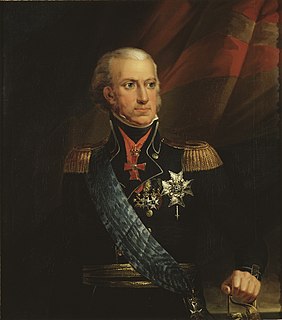
Charles XIII & II also Carl, Swedish: Karl XIII, was King of Sweden from 1809 and King of Norway from 1814 until his death. He was the second son of King Adolf Frederick of Sweden and Louisa Ulrika of Prussia, sister of Frederick the Great.

The House of Vasa was an early modern royal house founded in 1523 in Sweden, ruling Sweden 1523–1654, the Polish-Lithuanian Commonwealth 1587–1668, and the Tsardom of Russia 1610–1613. Its agnatic line became extinct with the death of King John II Casimir of Poland in 1672.
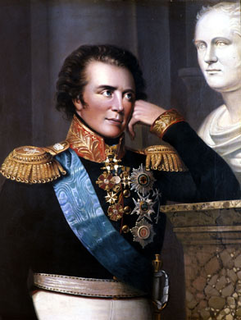
Count Gustaf Mauritz Armfelt was a Finnish, Swedish and Russian courtier and diplomat. In Finland, he is considered one of the greatest Finnish statesmen. His advice to Russia's Tsar Alexander I was of utmost importance for securing the autonomy of the Grand Duchy of Finland.
This is a History of Sweden from 1772 through 1809, more known as the Gustavian era of Kings Gustav III and Gustav IV, as well as the reign of King Charles XIII of Sweden.

The Russo-Swedish War of 1788–90, known as Gustav III's Russian War in Sweden, Gustav III's War in Finland and Catherine II's Swedish War in Russia, was fought between Sweden and Russia from June 1788 to August 1790.

The Battle of Svensksund was a naval battle fought in the Gulf of Finland outside the present day city of Kotka on 9 and 10 July 1790. The Swedish naval forces dealt the Russian fleet a devastating defeat that brought an end to the Russo-Swedish War of 1788–90. The battle is the biggest Swedish naval victory and the largest naval battle ever in the Baltic Sea.

The Dalarna Regiment, designations I 13 and I 13/Fo 53, was a Swedish Army infantry regiment that traced its origins back to the 16th century. The regiment's soldiers were originally recruited from the province of Dalarna, where it was later garrisoned. The unit was disbanded as a result of the disarmament policies set forward in the Defence Act of 2000.
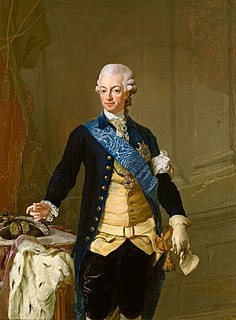
Sweden's Constitution of 1772 took effect through a bloodless coup d'état, the Revolution of 1772, carried out by King Gustav III, who had become king in 1771. It established once again a division of power between the parliament and the king. The period came to be known as the Gustavian era. This was a response to a perceived harm wrought upon Sweden by a half-century of parliamentarism during the country's Age of Liberty practiced according to the Instrument of Government (1719), as many members of the Swedish parliament then used to be bribed by foreign powers.

Fredrik Henrik af Chapman was a Swedish shipbuilder, scientist and officer in the Swedish navy. He was also manager of the Karlskrona shipyard 1782-1793. Chapman is credited as the worlds first person to apply scientific methods to shipbuilding and is considered to be the first naval architect.
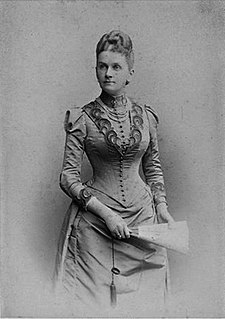
Carola of Vasa was a titular princess of Sweden, and the queen consort of Saxony. She was the last Queen of Saxony.

The Battle of Viborg Bay was a naval battle fought between Russia and Sweden on July 4, 1790, during the Russo-Swedish War (1788-1790). The Swedish Navy suffered heavy losses, losing six ships of the line and four frigates, but Gustav III of Sweden eventually ensured a Swedish naval escape through a Russian naval blockade composed of units of the Baltic Fleet, commanded by Admiral Vasili Chichagov. The battle ranks among the world's largest historical naval battles and also among the most influential, as it introduced the naval battle concept of "firepower over mobility".
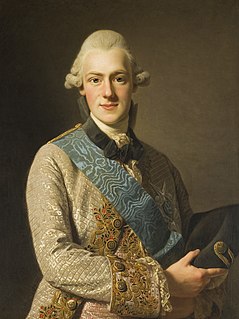
Prince Frederick Adolf of Sweden was a Swedish Prince, youngest son of King Adolf Frederick of Sweden and Louisa Ulrika of Prussia, a sister of Frederick the Great, King of Prussia. He was given the title Duke of Östergötland.

Amphion was the personal pleasure craft of king Gustav III of Sweden. She was designed by Fredrik Henrik af Chapman, built at Djurgårdsvarvet in Stockholm in the summer of 1778, and launched the same year. Amphion, named after Zeus' son and culture patron in Greek mythology, served as a royal yacht and headquarters ship. The ship was essentially a modified turuma, a type of shallow-draught frigate that served in the Swedish archipelago fleet. She was equipped with oars to allow her maneuverability of a galley while retaining a broadside of heavy guns and a full rig. She was equivalent to similar "archipelago frigates" of the archipelago fleet, but at Gustav III's request, she was built without heavy cannons and therefore differed significantly from the other ships of the same type.
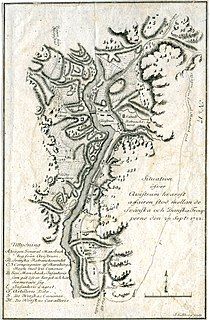
The Theatre War, Cowberry War, Cranberry War or Lingonberry War, was a brief war between Denmark–Norway and Sweden, starting on 24 September 1788, formally lasting until 9 July 1789. Although the decision to launch the attack was taken in Denmark, the majority of the attacking soldiers were Norwegians from the Danish-Norwegian army.

Gustav III was King of Sweden from 1771 until his assassination in 1792. He was the eldest son of Adolf Frederick, King of Sweden and Queen Louise Ulrika, and a first cousin of Empress Catherine the Great of Russia by reason of their common descent from Christian August of Holstein-Gottorp, Prince of Eutin, and his wife Albertina Frederica of Baden-Durlach.

A turuma was a type of warship built for the Swedish archipelago fleet in the late 18th century. It was specifically developed for warfare in the Archipelago Sea and along the coasts of Svealand and Finland. The turuma was designed by the prolific naval architect Fredrik Henrik af Chapman for use in an area of mostly shallow waters and groups of islands and islets that extend from Stockholm all the way to the Gulf of Finland.
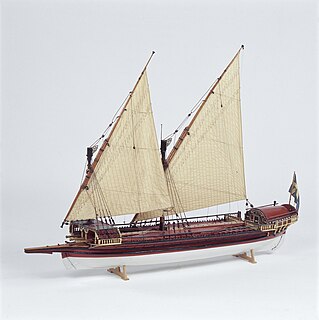
The archipelago fleet, officially the Fleet of the army, was a branch of the armed forces of Sweden which existed between 1756 and 1823. Its purpose was to protect the coasts of Sweden, which was surrounded by a natural barrier of archipelagoes. Throughout its existence, it was a largely independent arm of the army, separate from the navy, with the exception of a few years in the late 1760s. In a number of respects, it was a precursor of the Swedish Coastal Artillery and it's coastal fleet.

The battle of Fredrikshamn was an attack by the Swedish archipelago fleet on their Russian counterparts near the town of Fredrikshamn during the Russo-Swedish War (1788–1790).
Johanna "Jeanna" von Lantingshausen, née von Stockenström, (1753-1809), was a Swedish noble and courtier. She is foremost known as the instigator of the political demonstration by the noblewomen toward Gustav III in opposition of his parliamentary act of 1789.

Gustavus Adolphus, also known in English as Gustav II Adolf or Gustav II Adolph, was the King of Sweden from 1611 to 1632 who is credited for the founding of Sweden as a great power. He led Sweden to military supremacy during the Thirty Years' War, helping to determine the political as well as the religious balance of power in Europe. He was formally and posthumously given the name Gustavus Adolphus the Great by the Riksdag of the Estates in 1634.

















